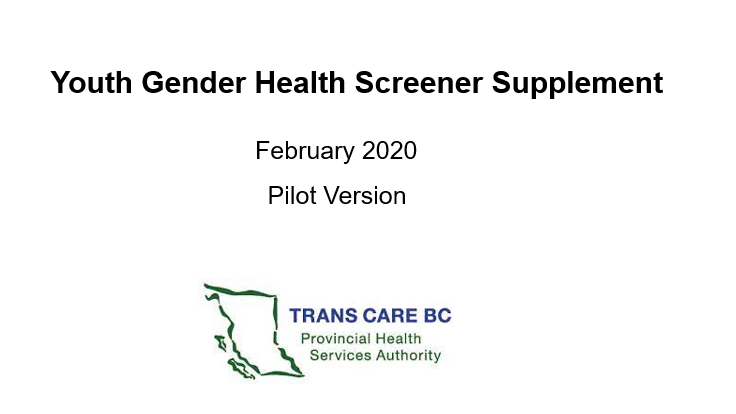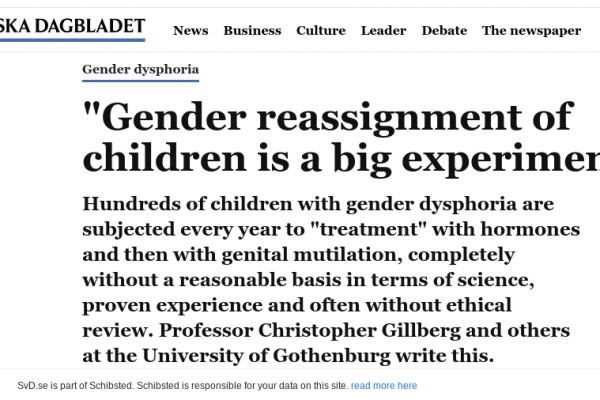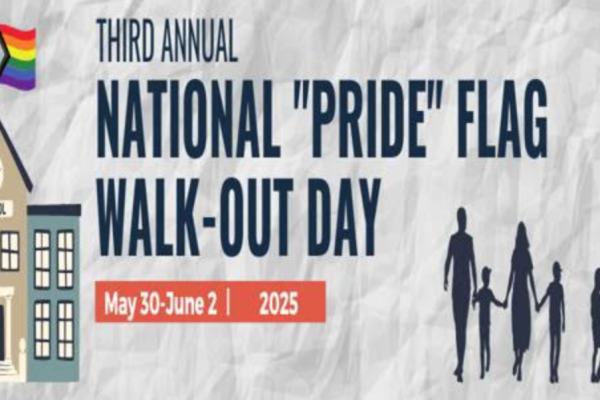TransCare BC continues to lead the world as an innovator of gender affirming care. The organization released a “Youth Gender Health Screener” a couple of months ago as their latest innovation in the field. The purpose of this screening tool is to be used across the healthcare system in primary care, to assist clinicians in identifying whether youth are experiencing issues that are related to their gender and identify “gender affirming goals of care”.
The document covers a vast array of topics that could come up in many situations with children and adolescents. The scope of the document is intended to “only be used with clients who have identified care needs related to gender diversity, gender questioning or gender affirmation/transition”, however, it’s not clear how a healthcare practitioner would establish that this is the case with young people for whom identity development is ongoing.
The intent of the screener is stated as an “all-in-one place tool to help highlight gender health areas of enquiry”.
“Gender health refers to the ability of an individual to live freely in the gender that feels more real or comfortable.”
TCBC Document – citing Ehrensaft, 2016; Hidalgo et al.,2013
This definition of gender health may make sense for adults who have had ample time and space to determine how they want to “live freely” in their gender, but for children and adolescents who are going through the often uncomfortable changes experienced in puberty along with a natural period of identity exploration and development that can change over time, gender is a much more nebulous concept.
The stated purpose of the screening tool is:
What is gender?
Gender is never defined in the screening tool other than as a concept that is somehow different from “sex assigned at birth”.
“In this document, we use trans to refer to individuals who are gender creative, nonbinary, transgender or have any other gender that does not align with the sex assigned to them at birth. Children refers to young people who have not yet reached puberty and youth refers to those in or beyond puberty, up to age 19.”
It states, somewhat unhelpfully: “Some young people are clear about their gender and others are exploring what gender means for them. Information about gender possibilities, for example non-binary genders, can help young people find the words they need to describe their experience of gender. Young people may be supported in exploration of gender and options for social and medical affirmation or transition by family, peers, and professionals.”
Gender is not defined, yet everything in the screening tool relates back to it. “Are you bullied and is it due to your gender?” “Have you experienced trauma and is it due to your gender?” “Do you have difficulties with social relationships and is it due to your gender?”
The responsibility of trained healthcare clinicians to objectively assess whether the issues that a youth is experiencing are due to “gender” or other factors is never addressed. Instead, the document steers clinicians to ask leading questions of youth who may be influenced to think that all of their problems are due to gender. Transition is unquestioningly positioned as the only solution, rather than helping youth to see gender through a lens of cultural and social factors that can change over time.
While the tool appears to acknowledge this: “Gender diversity is best understood as an interplay of biology, the environment, and cultural factors in an individual’s life (Hidalgo et al., 2013; Rosenthal, 2014).” there is no corollary acknowledgment that one’s experience of gender may be related to cultural factors such as harmful gender stereotyping and that there are options other than social and medical transition to manage the distress that one can feel due to this complex interplay.
Cultural and environmental context
One of the most significant environmental and cultural factors impacting youth today is the advent of social media and the immersion in the promotion of a new transgender culture that many youth seem to be turning to as a form of escape when faced with difficulties fitting in or going through the normal anxieties of adolescence. The document completely ignores these recent cultural changes as potential influencers for children and youth in how they are coming to understand themselves in the world. It is unethical on the one hand, to acknowledge that gender involves cultural factors, and on the other, to ignore the cultural context that has changed so dramatically in the last 10 years as rates of adolescents seeking gender transition have skyrocketed.
Social media influence
Even more disappointing is that the document seems to assume that “connection with others” made online can help build confidence and self-esteem and that the only safety issues that trans youth may experience online are related to harassment or bullying related to gender.
The focus on “encouraging youth to maintain healthy boundaries and access safer online spaces” while calling out detransitioner and ROGD sites as “transphobic” serves only to shift the discussion of online influences into an “us” vs “them” dynamic, rather than using this opportunity for a serious inquiry into a young person’s online and social media habits to determine if they are engaged in unhealthy social media behaviour that may signal underlying issues that need to be addressed which may or may not be related to gender.
Many detransitioners are reporting that they were drawn into social and medical transitioning because of their unhealthy and obsessive social media habits. It is irresponsible to ignore this important cultural context. Healthcare professionals who are interested in positive long term outcomes for trans youth need to be more open to understanding how social media is affecting today’s youth and it’s possible relationship to the explosion of young people who are adopting a gender identity that is different from their biological sex. It is not understood by our healthcare system what kind of long-term impact the influence of social media will have on a young person’s sense of self and gender identity. Missing from the document is any discussion or questioning of youth to understand whether external influences may be impacting their identity development in a manner that may impair long-term positive health outcomes.
Nevertheless, the document is very clear that the role of parents is to “fully support their child’s gender goals” and this screening tool has been developed to ensure that healthcare clinicians unquestioningly apply the affirming approach to care.
Gender Health – Period suppression
Current practice in Canada is to offer adolescent trans-identified youth puberty blockers to stop menstruation if they express discomfort or a desire to suppress their period. GP’s and others are not offering other, non-experimental options such as female contraception that leverages minor dosing of hormones and can achieve a significant level of suppression of unwanted bleeding. Parents have expressed that the need to advocate for non-experimental and non-invasive forms of medicalization is a concern.
The screener does not address any of the risks or trade-off decisions involved in various medicalization options, such as when to prescribe puberty blockers vs other, less risky options such as female contraceptives.
ASD/Autism
It’s positive that the screening tool recognizes the complex needs of adolescents with ASD. However, many teen girls on the spectrum go undiagnosed until adulthood or are misdiagnosed with another condition. Even a conscientious clinician who wanted to follow all the guidelines in the screening tool may not follow the additional guidelines for ASD if their patient doesn’t have a diagnosis.
The document mentions the possibility of ASD co-occurring but it does not recommend screening for ASD. Unfortunately, the information that females present differently from males on the spectrum is still not well known among educators and health professionals. The assumption of many GP’s is that a child’s school would have identified and assessed for autism. This leads to missed diagnoses which may help children and young people better understand their experience of gender.
Understanding and managing gender distress without the help of medicalization does not seem to be a goal of the screener, otherwise, ASD/Autism screening would be a recommendation.
The additional guidelines for patients with ASD are valuable but may be problematic to put into practice. Examples:
The tool mentions the need to increase awareness of options. How does that work with the affirmation model and Bill C-6? What options other than medical transition will healthcare professionals be able to suggest to a young person who has a transgender identity without threat of criminal prosecution? “Options” are effectively being ruled out by our federal government, under direction of transhealth professional associations who consider any alternative therapeutic approaches to medical transition to be conversion therapy.
The tool recommends collaboration with autism service specialists. Psychologists and psychiatrists who work with adolescents on the ASD spectrum have very long waiting lists. It may be feasible to collaborate with autism service specialists with patients who have both a prior ASD diagnosis and generous extended health coverage but it’s likely much more difficult for patients with ASD whose services have come through the school system and extremely difficult for a patient with a new diagnosis who is trying to set up a network of help. Once a patient ages out of the school system it is harder to access services.
The screening tool mentions the need to communicate clear information about medical interventions to youth with ASD in an accessible manner to facilitate informed decision making. This is valuable, but again would require specialized training on the part of the clinician obtaining the consent for treatment. In practical terms, this does not happen today.
Sexual orientation
The sexual orientation section of the screener mentions that youth may benefit from support exploring their sexuality but it doesn’t touch on the fact that for some LGB individuals the feelings of gender dysphoria resolve or diminish as they learn to accept, acknowledge or discover their same sex orientation. This is a major omission.
There are no recommendations or suggestions in the screening tool that youth should be able to express a certain level of experience or comfort with their sexuality prior to the initiation of invasive medical procedures that may have adverse impacts on a young person’s developing sexuality.
Mental Health & Minority Stress
The screening tool is heavily weighted towards “minority stress” as an explanation for mental health issues that gender questioning youth may experience. While it’s important to recognize the adverse affects of discrimination and bullying that trans-identified youth experience, the focus on minority stress ignores evidence and research that points to more complexity. Further, between the need to unquestioningly affirm a young person in their gender identity and the positioning of minority stress as an explanation for mental health issues, many healthcare clinicians may completely avoid screening or exploration of other important issues that may be contributing to a young person’s distress.
The minority stress explanation is a presumption that relegates any other possible causes of discomfort in one’s body as secondary, including factors that can affect a youth’s identity exploration or ability to form relationships. A recent study found that young people presenting with gender dysphoria were more likely to have childhoods characterized by high-risk attachment patterns to caregivers and high rates of unresolved trauma/loss.
One would think that a “Youth Gender Health Screener” that puts forward gender as a relationship between various factors, including environmental and cultural context, would include a discussion of the complex interplay between these factors, including adverse childhood experiences (abuse, neglect and so on) and the quality of a child’s attachment relationships, that can influence a child’s developmental pathway. The study concluded “Akin to children with other forms of psychological distress, children with gender dysphoria present in the context of multiple interacting risk factors that include at-risk attachment, unresolved loss/trauma, family conflict and loss of family cohesion, and exposure to multiple adverse childhood experiences.”(1)
Some acknowledgement of these risks and a discussion of the characteristics of developmental pathways that may lead children to an outcome of gender dysphoria that involves the consideration of life-changing medicalization would be helpful for healthcare clinicians. The screener does not include any of these.
Further, gender affirmation in early childhood which denies the reality of biological sex is never acknowledged as a possible contributing factor to the feelings of distress that children may experience as they enter adolescence. When children are affirmed in early childhood the child may be unprepared for the significant changes they will experience at puberty. The erroneous belief that biological sex is immaterial has been supported by adults and may be causing stress for a child who now needs to deal with the reality of their biology and who they are in the world.
Conclusions
What is completely missing from this document is any discussion of whether unquestioned gender affirmation is in the best long-term interests of children and young people. This screening tool adopts a position of “gender health” as a diversity issue in which children and young people should be able to self-determine their ideal physical characteristics in order to “live freely in the gender that feels more real or comfortable” (their definition of gender health).
Medicalization is the only option promoted to help young people address “gender health” issues. The screener requires unquestioned support from parents and caregivers and is extremely biased towards the “minority stress” explanation while ignoring other evidence and research on developmental pathways and early relational issues as a key aspect of the environmental factors.
The screener adopts a very sensitive but not very specific approach to identifying gender affirming goals of care for gender non-conforming children. The screener offers no guidance to healthcare clinicians to assess whether medical transition is in a young person’s long term best interest, but instead promotes the philosophy of unquestioned affirmation and a child-led approach. This may inadvertently move gender-questioning young people onto a treatment path that may not be appropriate, particularly when it leads to irreversible medicalization options, recently analyzed in the UK and found to have “very low” evidence.(2,3)
The relatively high sensitivity and low specificity of this tool should be a red flag to any healthcare clinician that it is appropriate as a tool in a primary pediatric setting that can lead to the prescribing of life-changing and experimental medical interventions for youth.
We would like to see an independent review of this new Youth Gender Health Screener to ensure that this kind of screening does not lead to over-medicalization of vulnerable youth who may be experiencing distress that might be too easily ascribed to “gender” rather than the natural identity exploration and discomfort with physical changes that many youth experience during adolescence.
- Kozlowska, K., Chudleigh, C., McClure, G., Maguire, A. M., & Ambler, G. R. (2021). Attachment Patterns in Children and Adolescents with Gender Dysphoria. Frontiers in Psychology, 11, Article 582688. https://doi.org/10.3389/fpsyg.2020.582688.
- Evidence review: Gonadotrophin releasing hormone analogues for children and adolescents with gender dysphoria Source: National Institute for Health and Care Excellence – NICE;NHS England; Publication date: 11 March 2021
- Evidence review: Gender-affirming hormones for children and adolescents with gender dysphoria Source: National Institute for Health and Care Excellence – NICE; NHS England; Publication date: 11 March 2021




